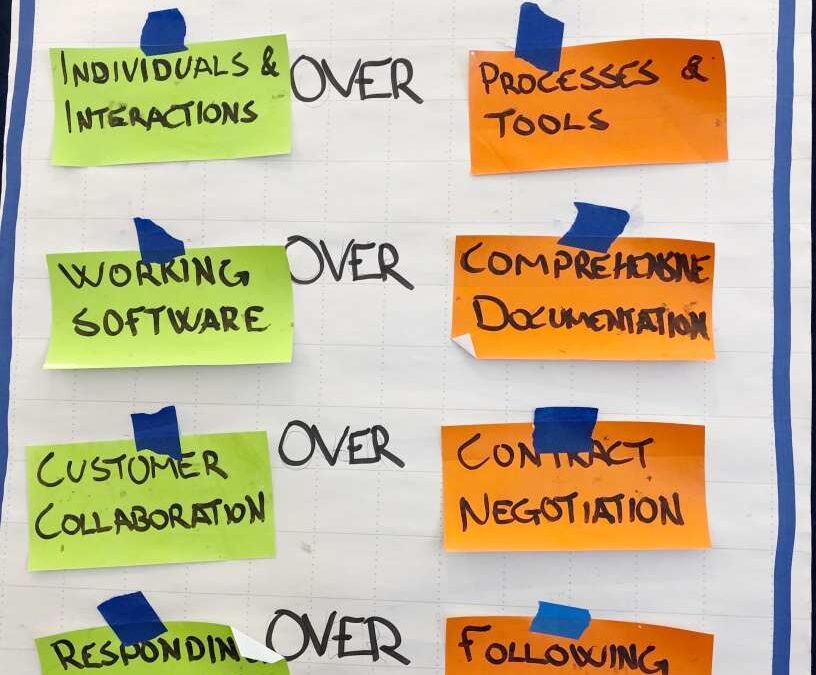The Agile Manifesto, created in 2001, has revolutionized the software development industry by promoting a flexible and collaborative approach to project management. It emphasizes individuals over tools, current software over detailed documentation, customer collaborations over negotiating contracts and delivering change over being fixed to a plan.
However, despite its widespread adoption, some practices don’t align with the Agile Manifesto. In this article, we will explore these misfits and their impact on project management.
The Agile Manifesto: Values and Principles
To fully grasp what does not match with Agile Manifesto, it is essential to understand the underlying values and principles. The Agile Manifesto is a set of guiding principles for software development that has gained widespread adoption across industries.
Although its roots lie in software development, the Manifesto has become a set of values and principles for any project management methodology that emphasizes collaboration, flexibility, and rapid iteration.
It prioritizes working software that meets immediate customer needs and encourages active customer involvement throughout the development process. Additionally, the Agile Manifesto emphasizes the importance of embracing change and responding to feedback to deliver early business value continuously and consistently.
Common Misconceptions About Agile
Despite its effectiveness in boosting team productivity, there are still common misconceptions surrounding Agile that lead to confusion and uncertainty. The following statements are some of the common misconceptions associated with Agile and we debunk them to provide clarity on the topic.
1. Agile is Only for Software Development
A common misconception about the way Agile works is that it applies only to software development projects. However, Agile can be used in any field that requires project management with short iterations, including marketing, finance, and healthcare. Agile can be beneficial in any project where continuous delivery is required, and there is a constant need for adapting to changes.
2. Agile Methodology is Anarchic and Lacks Structure
Another misconception about agile is that it is an anarchic approach that lacks structure. The truth is that Agile is a highly structured approach that requires strong discipline in its implementation. The Agile framework involves a predefined set of rules and a strict process for implementing them. Agile requires a lot of planning and preparation, and it is essential to follow the set rules and assign tasks as detailed to achieve success.
3. Agile Means No Documentation
Some people believe that agile means no documentation at all. However, that is not the case. Agile emphasizes creating only the necessary documentation that is vital to the project to avoid wasting time on creating unnecessary documentation. For an Agile project to succeed, there must be comprehensive documentation responding for stakeholders to understand the progress and outcome of the project.
4. Agile Means No Project Plan
Another misconception is that agile means no project plan. Agile emphasizes having a flexible plan that can adapt to change. However, Agile requires a comprehensive plan that outlines the project’s goals, timelines, and deliverables. The plan must be updated regularly to reflect changes in the project, and it is essential to have a clear understanding of the project’s goals and deliverables.
5. Agile is a Silver Bullet
Lastly, some people believe that agile is the ultimate solution for all project management challenges. However, agile is not a silver bullet and may not be the best approach for all projects. Agile works best in projects that require rapid iterations and quick delivery. For longer projects or projects with rigid deliverables, other methodologies like Waterfall may be more effective.
Ready to make the most of the agile manifesto?
Contact Growth Hackers
Identifying Practices That Do Not Align with the Agile Manifesto
Agile methodologies have become increasingly popular in recent years, but it’s important to remember that not all practices that claim to be agile are truly aligned with the manifesto. Here are some common practices that do not align with the Agile Manifesto.
1. Waterfall Planning
Waterfall planning is a methodology that involves breaking down a project into sequential stages, with each stage completed fully before the next one can begin. While this approach can be useful for certain types of projects, it doesn’t align with the Agile Manifesto, which emphasizes adaptability and flexibility.
Waterfall planning assumes that all requirements can be identified and defined upfront, which is often not the case in software development. People who have worked with alternative software development methods find it impractical to work with the traditional Waterfall method.
2. Micromanagement
One of the hallmarks of agile methodologies is the emphasis on self-organizing teams. In contrast, micromanaging team members can lead to a breakdown in collaboration and impede progress. Trusting team members to take ownership of their work and make decisions together is a key part of the agile mindset.
Micromanagement also goes against the principle of valuing individuals and interactions over processes and tools, which is central to the manifesto.
3. Heavy Documentation
Agile methodologies prioritize working software over comprehensive documentation. While documentation can be helpful, too much emphasis on documentation can lead to delays and a lack of focus on the end product. Agile teams should strive to create just enough documentation to support the work, without getting bogged down in too much detail.
Additionally, documentation should focus on outcomes rather than outputs.
4. Lack of Continual Improvement
Continuous improvement is one of the core tenets of agile methodologies, but it’s not always practiced in the way it should be. Some teams may focus on completing tasks rather than reflecting on the process and looking for ways to improve.
Emphasizing output over outcomes can lead to a stagnant approach that doesn’t foster growth or learning. Agile teams should always be looking for ways to improve processes and outcomes.
5. Strict Adherence to Frameworks
Agile frameworks like Scrum and Kanban can be useful for providing structure to complex tasks and the development process, but it’s important to remember that they are just that – frameworks. Agile methodologies emphasize flexibility and adaptability, so it’s important not to become too rigid in adhering to a particular framework. Being willing to make changes and try new approaches is key to truly embracing the agile mindset.
The Impact of Practices That Don’t Align with Agile
What does not match with Agile Manifesto can have a significant impact on project management. Here, we explore some of these practices and their impact on the agile approach.
1. Traditional Project Management
Traditional project management is highly focused on creating a plan at the beginning of a project and sticking to it. This approach is not compatible with Agile’s values and principles, which are centered around flexibility, change, and continuous improvement.
In a traditional project model, the emphasis is on meeting deadlines and staying within budget, which can lead to a drop in the quality of the output. If you introduce traditional project management to an Agile project, it can lead to a decrease in team morale, not to mention the lack of flexibility which could cause unnecessary project delays.
2. Lack of Team Collaboration
In Agile projects, teamwork and collaboration are essential. When team members work alone or in silos, this can lead to problems. Collaboration is important because it ensures that everyone is on the same page and working towards the same goals.
When things go wrong or there is a need for change, everyone can be informed and involved in the process, making it easier to make adjustments and keep the project on track. If team members don’t collaborate during an Agile project, there are chances of things going wrong, and the final deliverable may not meet expectations.
3. Lack of Importance Given to Testing
Testing is integral to agile development, and this is because it helps to identify issues or potential problems early on in the process. In Agile, testing happens repeatedly throughout the development lifecycle, ensuring that bugs are identified and fixed promptly.
However, some organizations place little importance on testing and only do it at the end of the project, which wastes time and can potentially harm the quality of the final product. In Agile development, testing is done continuously to ensure that issues are caught early and addressed appropriately.
4. Over-Committing on the Work to Be Done
In Agile, it’s important to commit to only the work that can be accomplished within the specified duration. The team needs time to deliver quality work and needs to have enough time to complete the planned work within the required timeframe.
When teams over-commit to the amount of work to be done in a specified period, they might not deliver, and this impacts the team’s morale and confidence. It is important to set realistic levels of commitment to ensure that the project remains profitable and completed on time.
5. Failure to Adapt to Change
One of the pillars of agile is embracing change. Agile is all about continuous improvement and thriving in a rapidly-changing environment. However, some organizations resist change and stick to outdated processes. When an organization refuses to accept change over adhering to a plan, contract negotiation over customer collaboration, processes over interactions, working software against comprehensive documentation, and more, it will not be able to reap the benefits that agile promised, such as increased productivity, flexibility, and quality.
A failure to adapt to change can lead to missed opportunities and a decrease in overall project success.
Why it’s Important to Identify and Address Misfits With the Agile Manifesto
Identifying and addressing practices that don’t align with the Agile Manifesto is crucial for successful project management. By aligning with Agile values and principles, teams can improve collaboration, deliver value to customers, and respond effectively to change.
Addressing misfits also ensures that the benefits of agile, such as increased transparency and adaptability, are fully realized. Failing to address misfits can result in project failures, wasted resources, and missed opportunities for improvement.
It’s time to navigate the journey to agile excellence!
Strategies for Addressing Misfits and Promoting Agile Values
Addressing misfits with the Agile Manifesto requires a proactive approach. One strategy is to educate team members and stakeholders about agile values and principles, helping them understand the rationale behind certain practices.
This can foster a shared understanding and commitment to Agile. Another strategy is to promote continuous improvement by regularly reviewing and adapting processes to better align with Agile values. This allows teams to identify and address misfits as they arise, ensuring that Agile practices remain effective.
Overcoming Resistance to Change in Agile Adoption
It is quite common to encounter resistance to change when concerned with the adoption of agile practices. To overcome this resistance, it is essential to communicate the benefits of agile to all stakeholders, emphasizing how it can improve project outcomes.
Providing training and support to team members can also help alleviate concerns and build confidence in agile practices. Additionally, involving stakeholders in the decision-making process and actively addressing their concerns can foster a sense of ownership and collaboration.
Final Thoughts on What Does Not Match with Agile Manifesto
Understanding the values and principles of the Agile Manifesto is crucial for successful project management. Identifying and addressing practices that don’t align with agile ensures that teams can fully embrace collaboration, flexibility, and continuous improvement.
By promoting agile values, organizations can improve project outcomes, deliver value to customers, and maintain a competitive edge in the rapidly evolving software development industry. And speaking of consistently maintaining sustainable business growth in this competitive industry, Growth Hackers is your one-stop solution to achieving your goals.
With our unique cutting-edge technologies and strategies, tailored to reach your business goals, we can help you achieve sustainable growth beyond traditional marketing methods. Our team of experts is equipped with the latest tools and methodologies to understand your target market, identify the best channels to engage with them, and apply data-driven analysis to optimize your marketing campaigns.
Contact Growth Hackers today to start accelerating your revenue growth with us!








